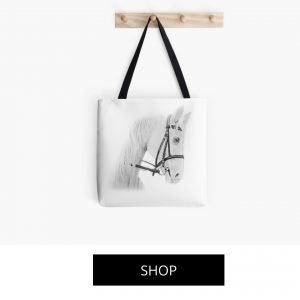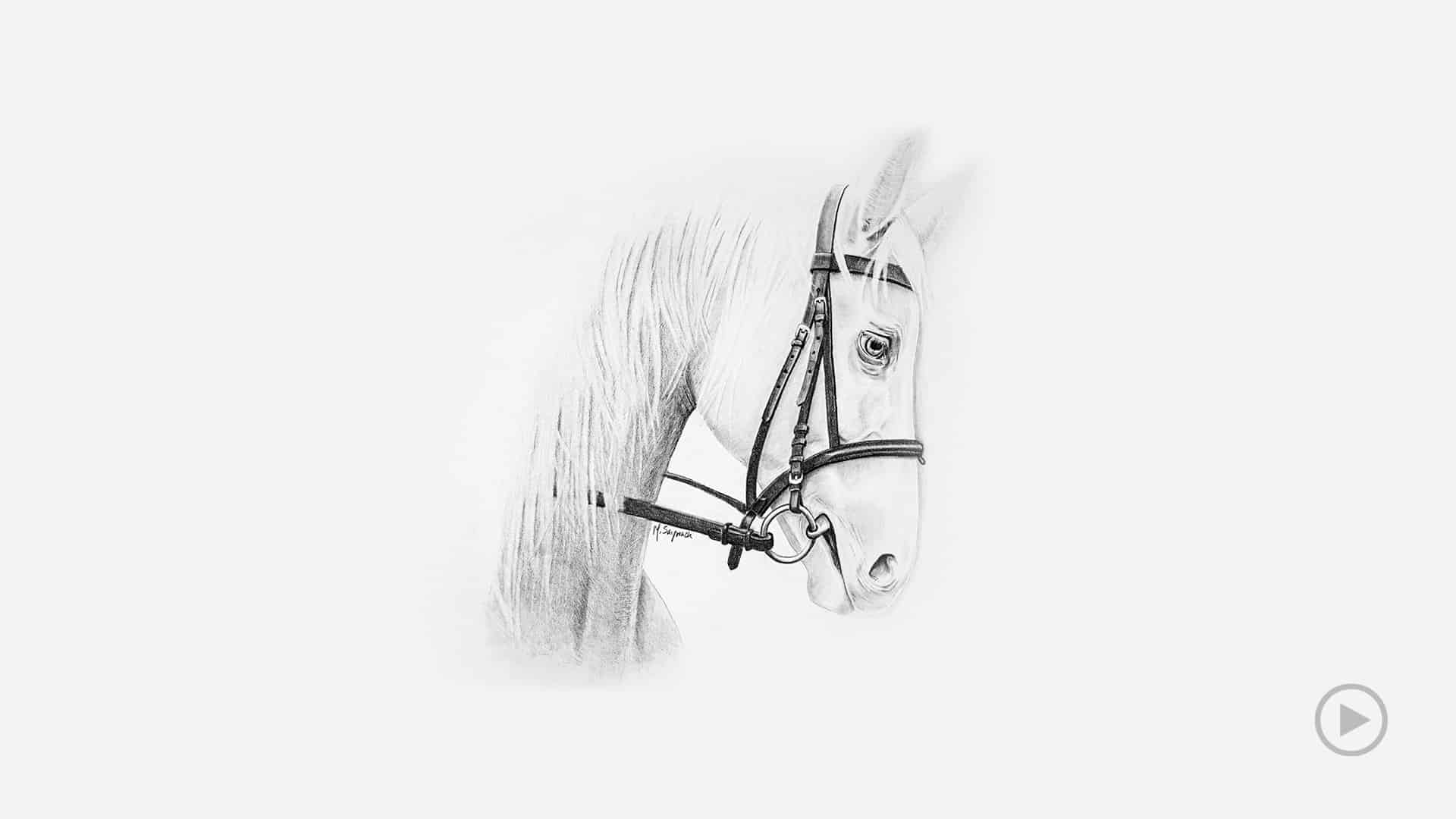The Inspiration
I chose this Cremello horse for this art video because of the animal’s beautiful eyes. If Old Blue Eyes could speak, what stories would he tell? His expression already spoke volumes, and I felt I had to capture that in hopes of sharing his story.
There is another reason for this post other than gaining some background on my inspiration. While researching, I came across the mention of a horse in a very unusual and unexpected place. I found that “horse” was the root word for something that had nothing to do with horses in an ancient text. Or did it? More on that later… I promise!
First, some interesting horse facts…
What is a Cremello Horse?
Cremello is the name of the animal’s coat color and can be produced in any horse breed. The Cremello is bred for its beautiful creamy-white coat, mane and tail, and pink skin. They also have blue eyes and no face markings.
While they are often mistaken for albino animals, true albinism is characterized by no pigment at all. Compared to the creamy Cremello, the Camarillo is the true white horse.
While Camarillo horses have been around for the last 100 years, they are challenging to breed because of their genetics. These white horses have a dominant (W) and or recessive (w) gene for white, which must be matched correctly in breeding pairs. The odds are 50/50 that a pairing will result in the foal not surviving at all. Because of this, there are less than 20 breeding pairs surviving today.
The ease of breeding Cremello horses has made them more common. They have become much more popular since the American Quarter Horse Association recognized them as a proper breed.
The Cream Gene
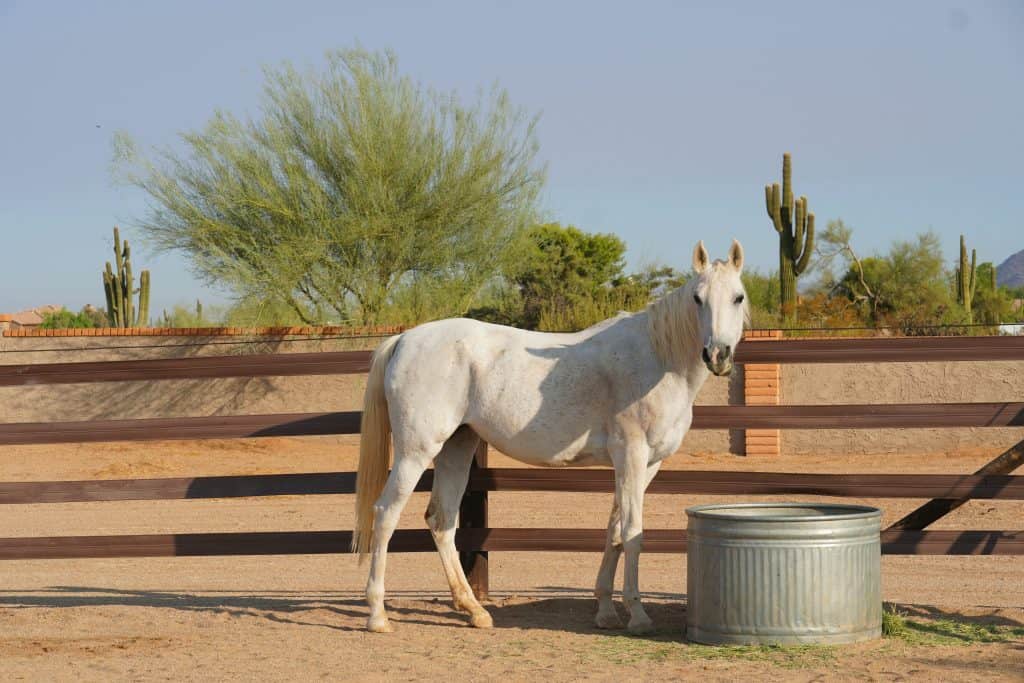
This next bit is for those who enjoy the science behind it all.
All-white foals are bred from mares and stallions of many different horses using the cream gene. It is also known as a dilution gene because it dilutes a darker color into a lighter one. Depending on the breeding pair, foals will inherit different shades of white or cream hair (coat) colors.
The odds of producing a white foal depend on the genetics of the dam and sire (mare and stallion) or the foal’s parents. Darker colors come from a single dilution, while the Cremello results from a cream gene pair, meaning the white foals inherit a copy of the dilution gene from both parents. This is known as double dilution.
Cremello foals begin life with a slightly darker coloring which gradually lightens as the animal grows.
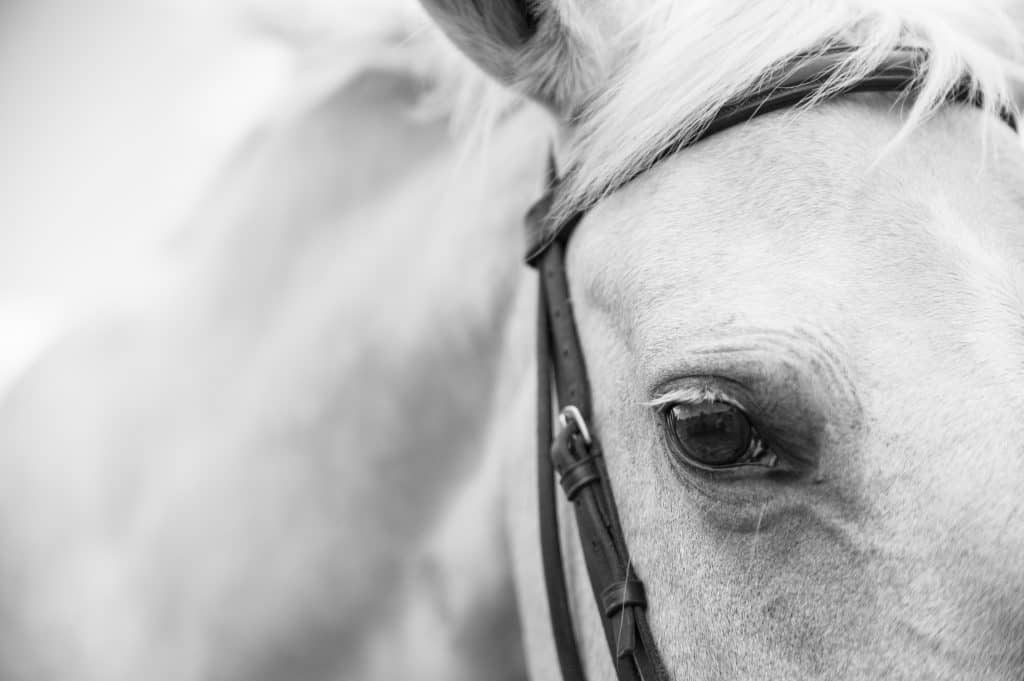
Only Skin Deep
The difference between cream dilute colors produced from different breeds depends on the parent’s basecoat or underlying skin coloring.
- A light Palomino foal has dark skin or base coloring.
- Perlinos have a bay base coat with a dark mane and tail.
- A Cremello’s rosy-pink skin comes from parents with a red or chestnut base coat.
Base skin coloring is evident where an animal’s skin shows through, like around the mouth and eyes. The beautiful horse pictured above has dark skin around its eyes, where the hair is not as dense.
While a horse’s coloring and breed are the most sought-after qualities, every horse is unique and beautiful. They are social creatures who affect and are affected by human interaction. Studies show that the health of the horse and its rider are often interconnected.
Genes, dilution, and horse breeds are fun and all, but they are nothing compared to what’s next.
Read on!
How Does a Horse Breathe?
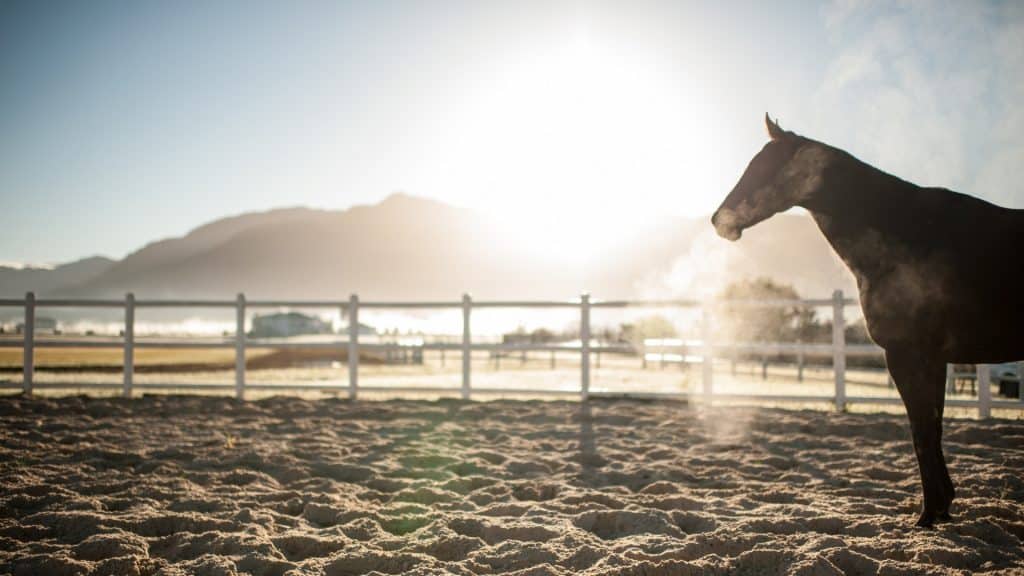
For me, the most remarkable trait of this magnificent animal is found in the simplest of processes – the way it breathes. Horses breathe the way we breathe, with one major difference – they inhale and exhale only through their noses. Horses cannot breathe through their mouths because of a membrane that blocks the passage of air between the mouth and lungs.
That’s not all!
Horses only breathe through their noses when resting or walking. When speed is required, another unique breathing ability comes into play.
Breath, Speed, and Endurance
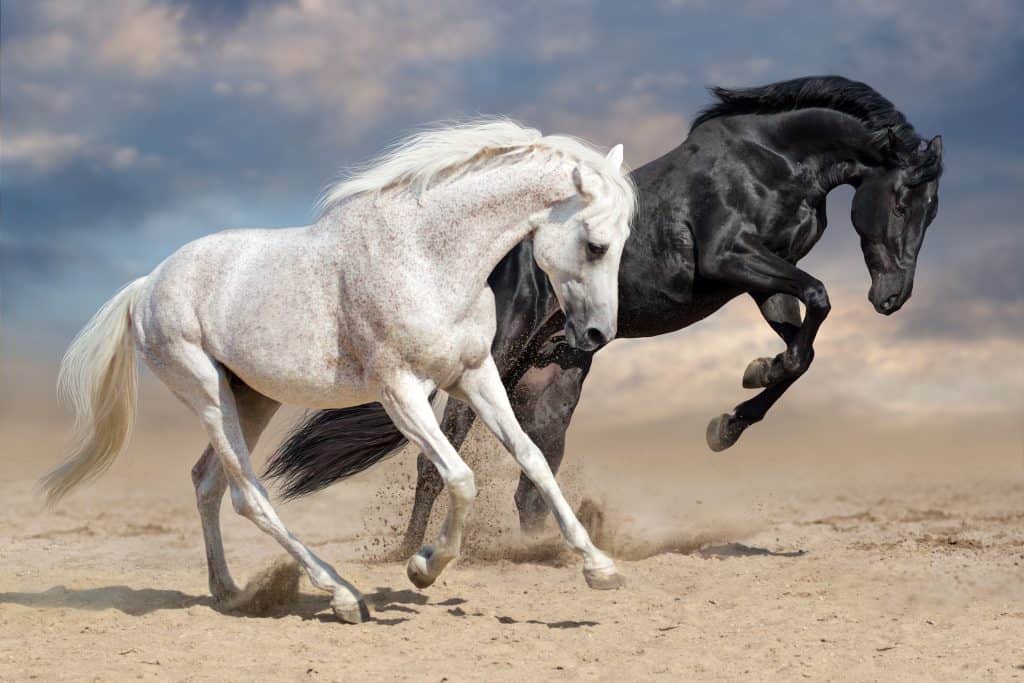
First, did you know each horse will run only at a pace unique to that animal? Training will not increase this pace.
Why is that important?
It’s important because a horse’s speed is proportional to its breathing. For that reason, when a horse begins to gallop, a super cool change in breathing mechanism occurs – a switch from voluntary to involuntary breathing.
We all know about lifting with your legs.
What about breathing with them?
Breathe With Your Legs
A closer look at the horse’s anatomy, especially where the lungs and the front legs are located, helps explain this. As a horse transitions from resting to running, a change occurs. The animal’s legs take over.
The action of the front leg muscles begins to “pump” the lungs to inhale and exhale. One step equals one breath. In other words, the horse can run as fast as its feet can pump its lungs.
How amazing is that! It’s like having an accordion for lungs except for speed and not sound. Ok, maybe more like those old-timey rail cars that you could pump with your arms?
Either way, it’s impressive!
But wait. There’s more…
What Are the Five Common Gaits of Horses?

If you are still not impressed, consider this. You may already know that horses have four common and distinctive traits. These are named by how the animal’s feet contact the ground, also referred to as “the beat.”
Like music theory.
A “walk” is called a four-beat gait, a trot is two, a canter is three, and a full gallop is four. You can try drumming your four fingers on your desk for each gait, but here’s also a video clip coming up that shows them all.
Four gaits are all good until the Icelandic horses show up.
These horses are genetically able to perform a 5th gait known as the “tolt.”
Icelandic “Tolt”
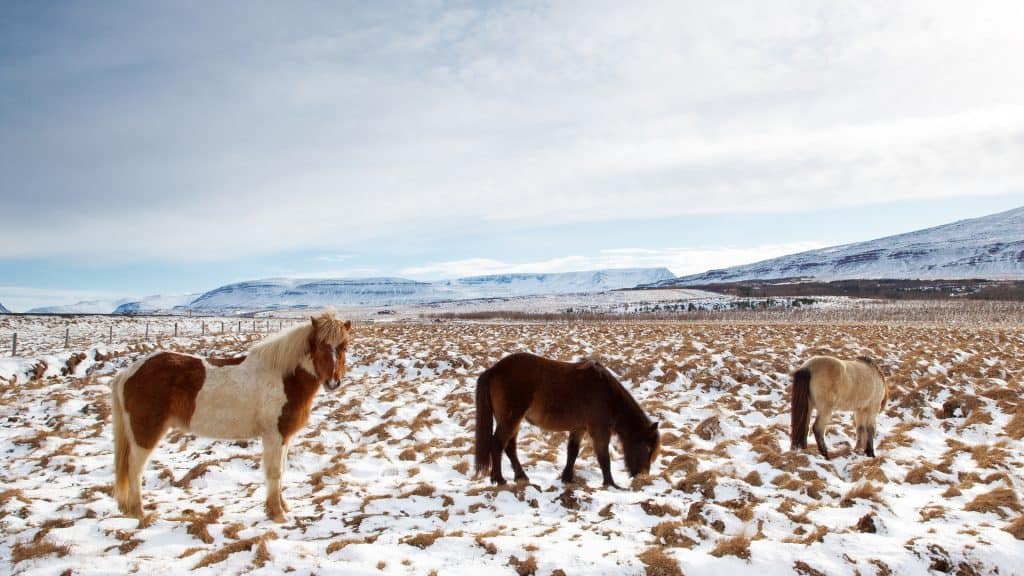
Icelandic horses are unique in their genetic make-up, which allows them to tolt. The tolt, which you can view in the link below, is where the horse seems to “jog” with its front legs (in a very human-like manner) while its hind legs gallop.
Tolting looks as unusual and impressive as it sounds, but fair warning – once you see those “jogging” legs, you will never be able to unsee it!
Now that we’re inside the gait, it’s time for the reveal – the reason for this entire post – the part about the most ancient mention of a horse.
“Spirit” in Genesis
One of my greatest passions is studying ancient Biblical Scripture by the root words and their meanings in the original Hebrew or Greek language. It gives me a clearer picture and often simplifies some of the most controversial verses.
It’s like hearing a rumor versus getting the truth straight from the horse’s mouth.
Pun intended.
“Spirit” is a common name for horses, and there’s even an animated movie about a beautiful stallion of the same name. And it’s no wonder since the word spirit embodies the beauty and magnificence of a wild horse.
Ok, enough teasing.
On to the root-word study that started it all.
The Root of the Matter
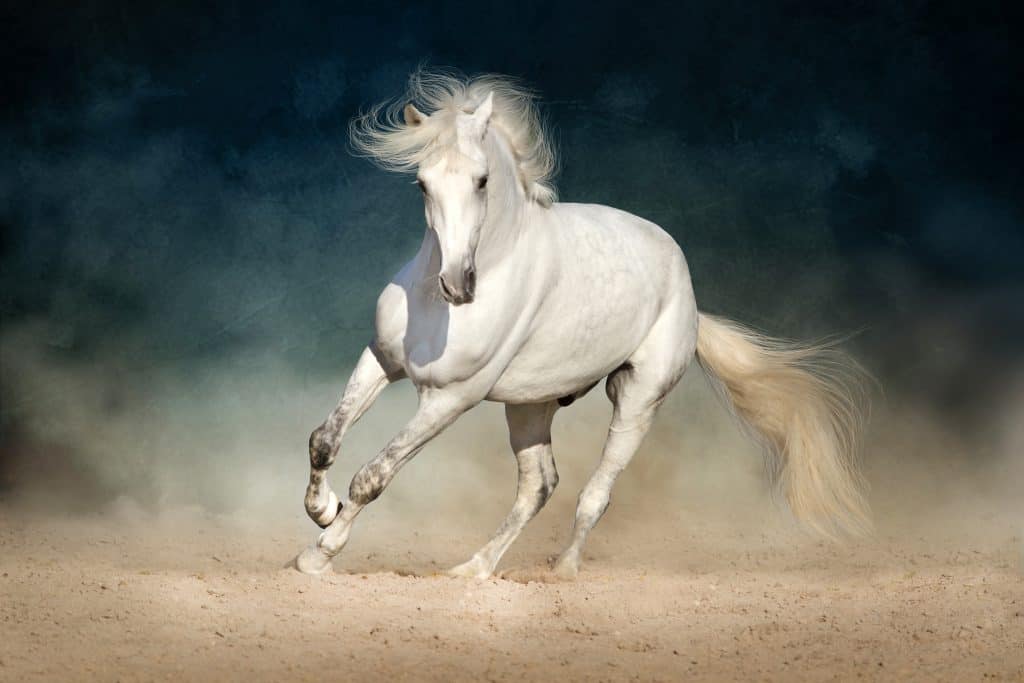
Genesis 1:2 mentions a horse in a very unusual place (which started me researching this entire post!). It reads,
“And the earth was without form and void, and darkness was upon the face of the deep. And the Spirit of God moved upon the face of the waters.”
While the word “Spirit” in this verse refers to the Third Person of the Trinity, it has a very unusual root word and meaning.
Ruach, the Hebrew word for Spirit (pronounced roo’- akh) is translated as breath, wind, or horse.
How Does the Spirit Move?
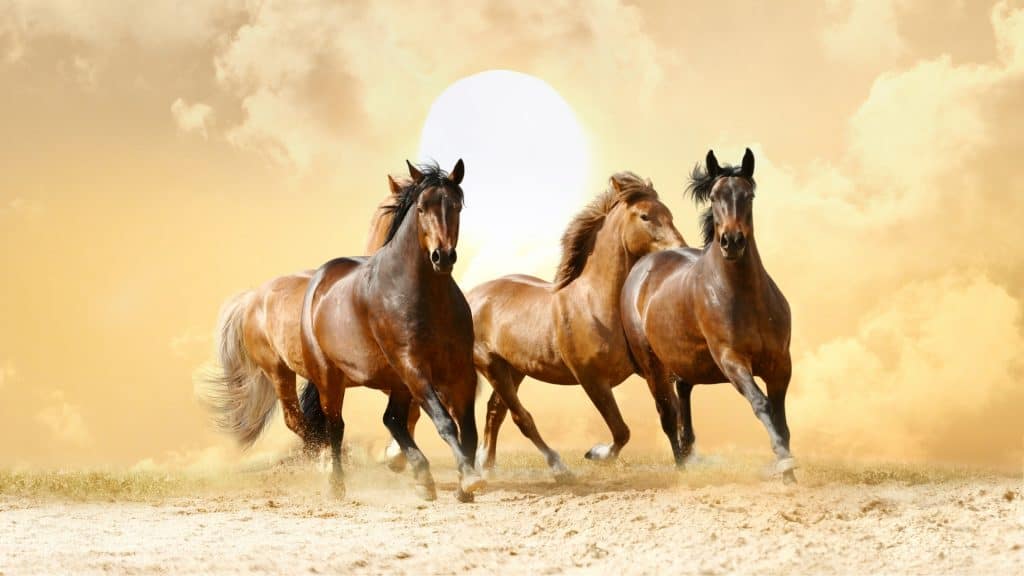
I’m hoping at this point that you are making the same connection I did when I first discovered the root meaning.
First, the word “breath” made me think about how a horse breathes when it gallops.
As the Creation event described in Genesis 1 unfolds the darkness of the beginning, it’s easy to imagine the powerful movement of galloping legs and the steamy breath escaping the animal’s nostrils. We can imagine the bright Spirit moving on the dark “face of the deep” as God spoke the universe into being. This was not a soft and whispering wisp but a swift and powerful Spirit moving to create life from nothing.
What a magnificent image of God’s Spirit!
I couldn’t stop there. I had to know more…
The Old Testament is full of instances where the Spirit of God also “came upon” someone. These chosen ones either displayed incredible physical strength or amazingly peculiar behavior.
Samson
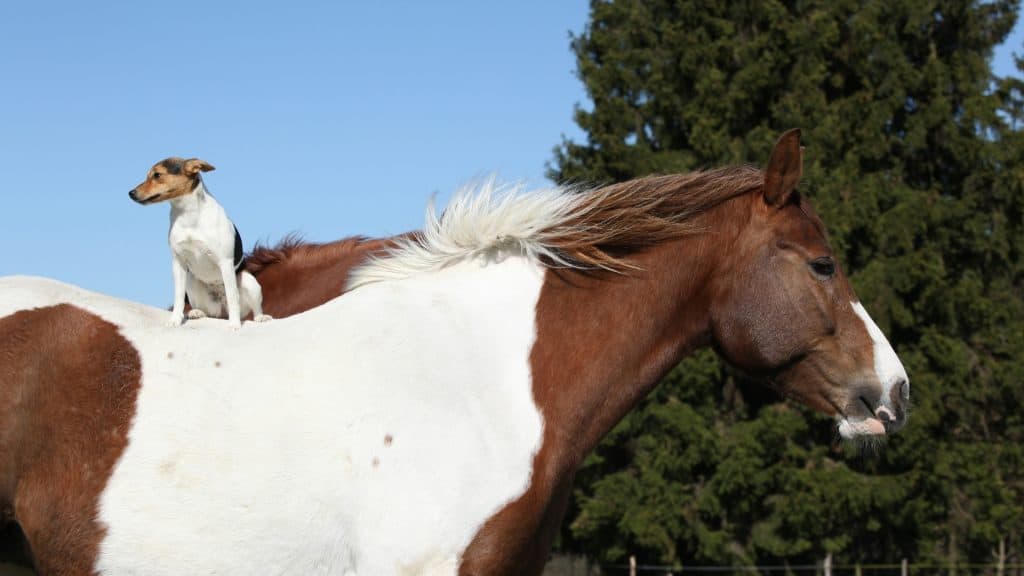
One giggle-worthy story is of a teenage tough guy named Samson. While he was out walking, one fine day, a lion jumped out of the bushes and attacked him. The Spirit of God “came upon” him, and Samson tore the beast apart with his bare hands (my apologies for the graphic description).
Apparently, Samson himself was just as surprised and freaked out by what took place. As the story goes, he quietly returned home and did not tell his parents about the odd-goings-on.
Imagining the great and mighty Samson a little out of sorts is definitely a laugh-out-loud moment! I can picture him like the teenage Spider-Man who suddenly develops superpowers he cannot understand. It makes him awkward and relatable all at the same time.
And Samson was not the only one…
Elijah
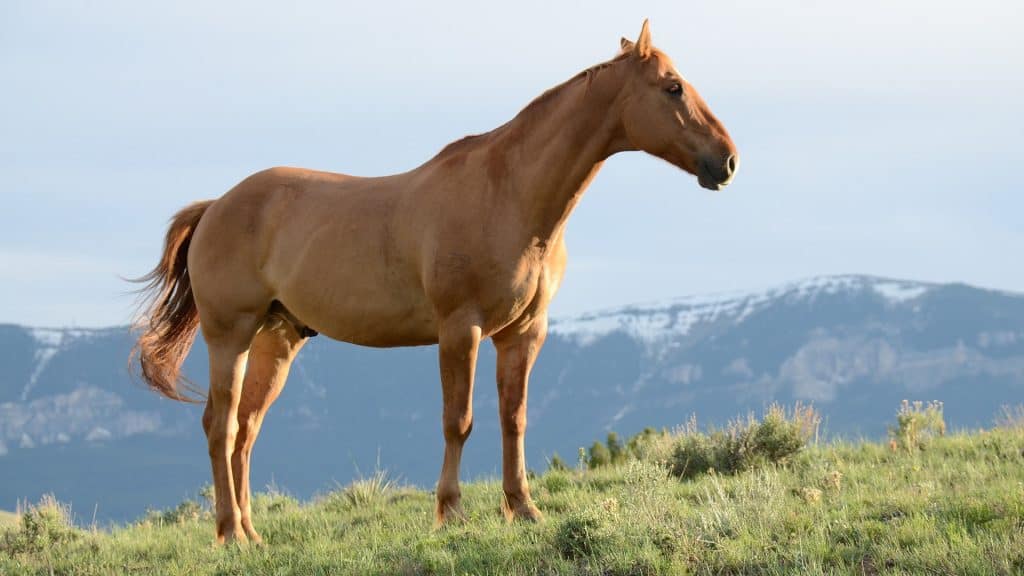
At other times, the Spirit of God physically moved a person from one location to another. One story about a prophet named Elijah especially captures the awe-inspiring and bewildering spectacle of being literally “moved” by the Spirit.
I mean, we’ve only seen things like that in the movies.
Obadiah was the manager of King Ahab’s household. I imagine he was not unlike Carson, the severe but secretly soft-hearted butler of Downton Abbey.
Queen Jezebel, King Ahab’s wife, was Obadiah’s boss. She was bent on murdering all of God’s prophets. Brave Obadiah hid 50 of these prophets in a cave, giving them his own food and water.
This might not seem like a big deal, except that there was also a terrible drought in the land.
Brave Obadiah

Obadiah was walking down the street when Elijah “suddenly” appeared before him. He had come with a message from God for cruel King Ahab and his wife. Regaining his composure after Elijah’s surprise appearance, Obadiah balked at the request. He said something like, “You must really hate me! If I go tell King Ahab you are coming to talk to him, and the Spirit of God makes you disappear to who-knows-where, the king will have my head!”
While I feel sorry for Obadiah, I wonder if he knew how amazing it was to witness the moving of God’s Spirit so many times that he didn’t wonder at it as we do.
Perhaps, in an age of superheroes, we have also lost the wonder of the stories passed down to us. I only hope it is because we have witnessed more extraordinary things, like the freedom that comes from God.
That brings us back to the very special subject I chose for this art video – Old Blue Eyes. What struck me was the bit and bridle that seemed to weigh down his magnificent head.
I couldn’t help but wonder if he and I could experience that kind of freedom.
Maybe you wonder too.
What is a Free Spirit?
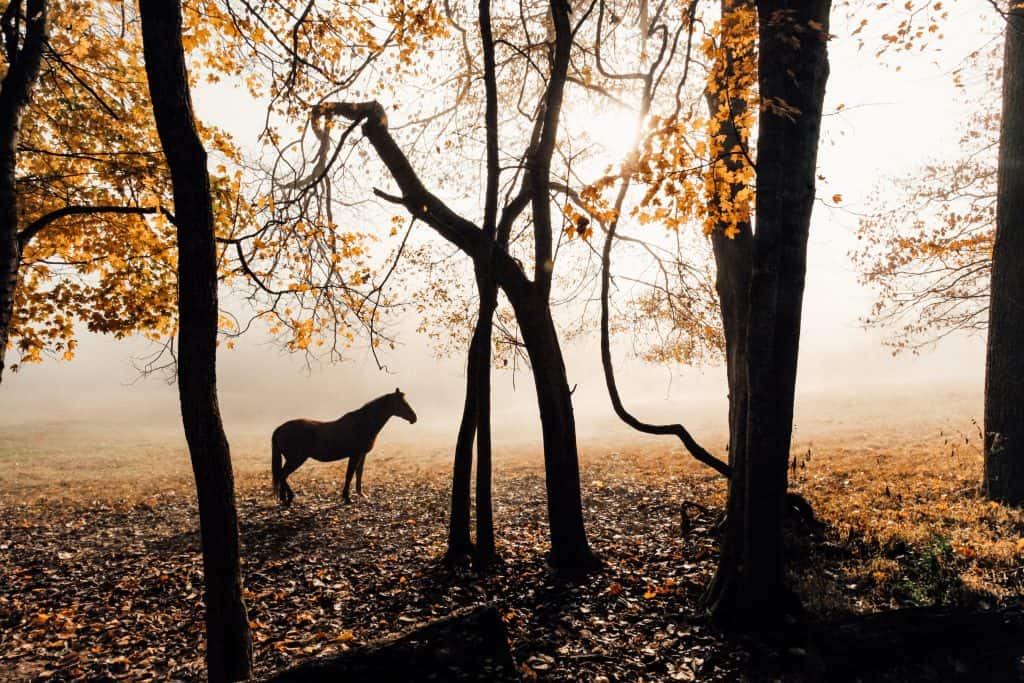
There are two things that come to mind when I think of getting a horse to go where I want – a bit and a bridle. So why did looking at Old Blue also tug at my heart?
The Bit and Bridle

First, the bit in the horse’s mouth turns its head in a particular direction. That tiny piece of metal trains and controls such a large and powerful animal.
How thought-provoking.
James 3:3-12 compares this little apparatus to the power of the tongue. Like the bit turns the horse’s head, words prove what influences and determines the direction a life is heading in. Thoughts become words that become actions and are a perfect snapshot of what is behind the reins – the heart.
Changing the words cannot change the heart. It’s the other way around. The heart is where the change from destructive actions to healthy needs to occur. Sadly, the heart is kinda stuck. It’s like not being able to breath through the throat. Change means making a switch from the heart to the spirit, just like the horse switches breathing mechanisms.
Scripture says that the Spirit of God brings abundant life. When the Spirit is in control of your life, He speaks to the thoughts, words, and motivates the actions that move toward that kind of life.
The Harness
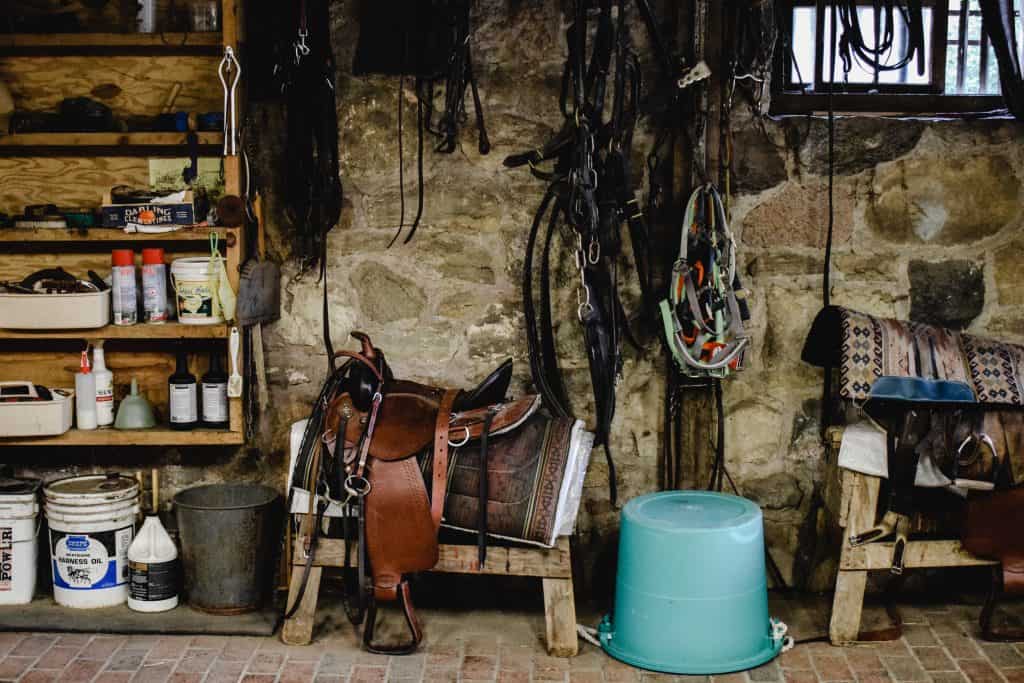
A harness is not a bad thing, but a wrongly attached harness can slow an animal down. To clarify, a harness that is strapped on too tight does not inhibit breathing. It can prevent the muscles that power the legs from working properly. If the horse can’t make the switch, it won’t reach its potential speed.
That’s a pretty simple lesson about not being tangled up in things that prevent us from the true purpose of life – Freedom.
The Spirit of Liberty
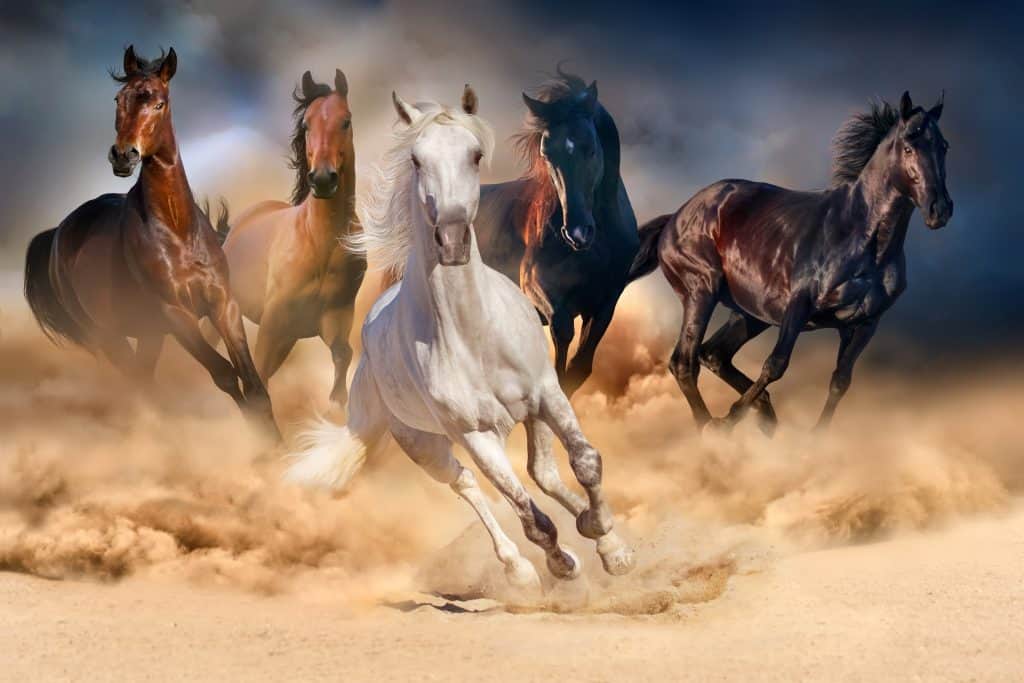
2 Corinthians 3:17 says, “Where the Spirit is, there is liberty.”
The word liberty sounds so much to me like unfettered, unbridled freedom.
What are you carrying that is weighing you down or keeping you from taking a step in faith?
We were born to be wild and not in the way that leaves us bound and in chains.
Finding that freedom takes a simple step.
You ask for help to make the switch. It’s that simple.
I saved the most important lesson for last because it is also the first.
The First Step
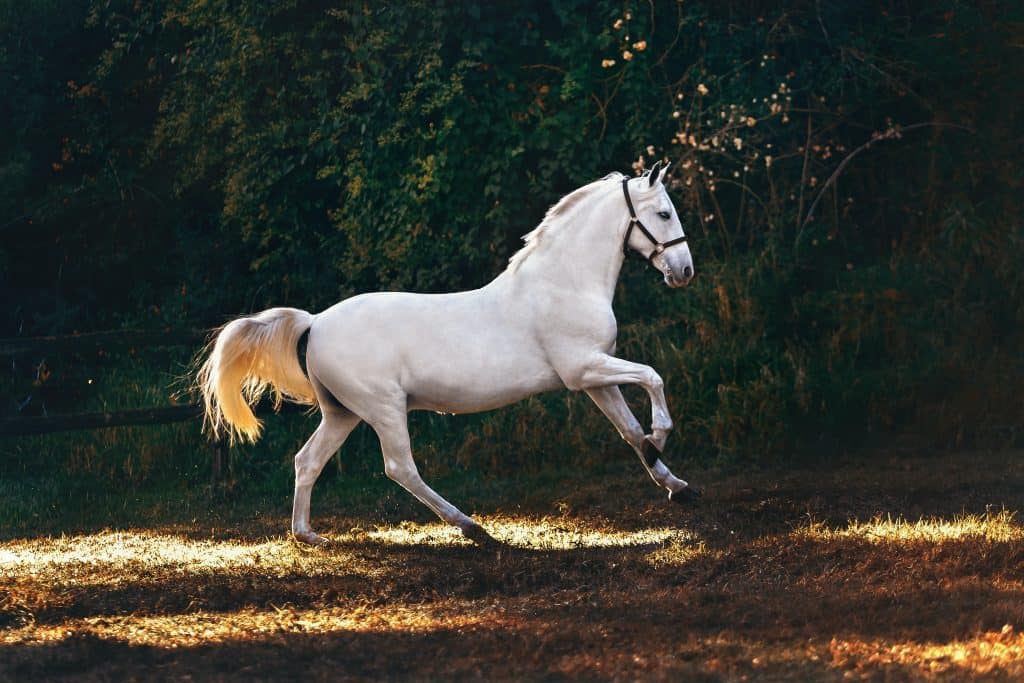
For a horse, one step equals one breath. That, to me, is the most important piece of information.
“For in Him we live and move and have our being.” (Acts 17:28)
We have to take the step, and the power of God will follow.
So many times in life, we wait for the power and don’t a step.
I guess that’s why it’s called a step of faith!
God made freedom available through Christ. All that means is you also need Someone to hook up the connection between you and God’s Spirit.
It is not something humanly possible.
The Yoke
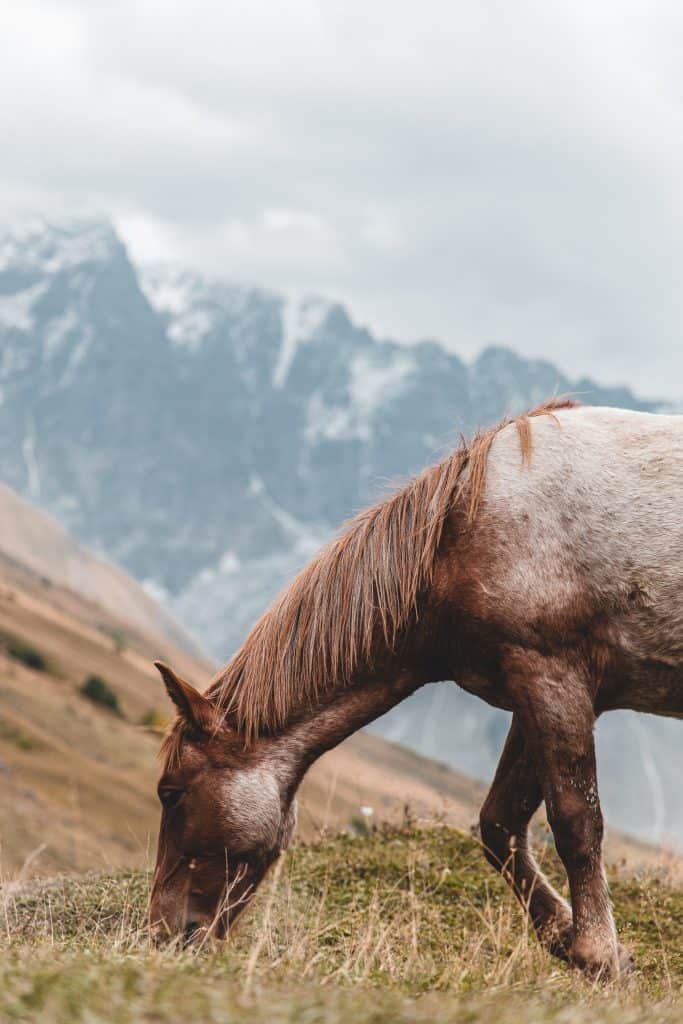
Jesus said, “Take my yoke upon you and learn of me; for I am meek and lowly in heart: and you will find rest for your souls” (Matthew 11:29).
A yoke that promises freedom?
Are you yoking?
Consider the power of electricity. It needs to be channeled through a transformer. The transformer’s job is to reduce the 7,200 volts down to the 240 volts that make up normal household electrical service. It also helps supply a constant level of electricity.
Anything that is constant is dependable. You can mentally rest knowing that your electricity needs are supplied.
We need a “transformer” between us and God’s powerful Spirit. Scripture uses the term “mediator” and there is only one – Jesus Christ – Son of God and Son of Man.
Every step you take when “yoked” with Christ breathes the new and constant power of the Spirit into you.
And, what kind of power is that?
It is power that raises dead things to life. That power.
Only A Step Away From Freedom
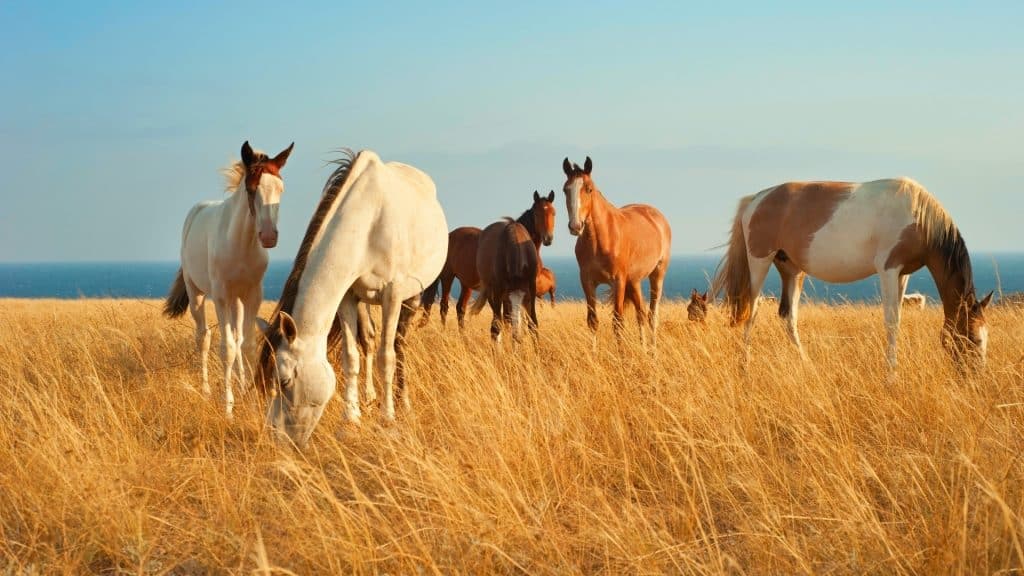
So breathe deep and take a step into the freedom you were meant for.
Ask. I did.
After that first step, take another and another until you are running wild with grace.
I ended the video with a tiny clip of a horse running with its herd. It helps me to remember that true Spirit-filled freedom is mine, and it’s enough to take my breath away.
If you want to know more about the freedom that comes from God, click here.
Looking for a unique gift or home decor? Click here for art prints, bags, COFFEE MUGS, and lots more.
See below for a few of our favorite picks.



